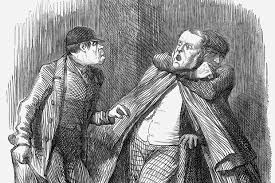
John Palmer was an ordinary sort of bloke. He gave his occupation as ‘labourer’ (frequently a default term for those appearing before the courts in Victorian London, suggesting he was a casual worker). He certainly wasn’t a rich man, by any stretch of the imagination and, as he walked home one late evening in March 1870, he only had a few shillings in his pocket.
This didn’t stop him falling victim to violence and robbery however. Palmer may have enjoyed a few pints after work, which would have made him more vulnerable to being attacked. He was hardly a prize though, but to James Tyson and John Sadler that didn’t matter. Tyson was a trained boxer – a pugilist to give the contemporary term – and so was well suited to a bit of ‘rough stuff’. Sadler was a betting agent, so also probably quite able to mix it when he needed to.
The pair fell on Palmer as he made his way home; Sadler jumped him, knocking him to the ground before Tyson used his weight to hold him down. They rifled his pockets and extracted 7 shillings and ran off. Palmer reported the incident to a nearby policeman who took descriptions and set a search in motion. The culprits were caught just a few hours later, one of them by a detective.
When Sadler was searched he was found to have quite a haul. The police discovered a number of pawn tickets (often evidence of theft) all for ‘valuable gold and silver watches’ as well as gold Albert chains and some broken watch-bows. Some of these might be able to be identified but even more significant a find was a gold locket ‘with a ruby heart at the centre’ and a Freemason’s gold medal. The medal was inscribed:
‘The Most Noble Augustus Frederick, Duke of Leinster, Grand Master of the order in Ireland, 3rdJanuary, 1848’.
Augustus Frederick, the Marquess of Kildare (right, below pictured in 1859) was an old man by 1870. Born in the previous century by the time his medal turned up in the pocket of a petty thief in London he was close to 80 years of age and would only live another three. He became head of the Grand Lodge of Ireland in 1813 and apparently kept a tight rein on how all Freemasonary operated on the Emerald Isle. 
In court at Marlborough Street the police reported that both James Tyson and John Sadler were well known to them. Mr Mansfield, the sitting Police Court magistrate, was told that there were ‘frequenters of racecourses’ and known to be ‘magsmen’ and ‘welshers’.
Eric Partridge’s 1949 Dictionary of the Underworld defines a ‘magsman’ thus:
‘Swell mobites’; ‘a fashionably dressed swindler’; or ‘fellows who are too cowardly to steal, but prefert o cheat confiding persons by acting upon the cupidity’. It included ‘card-sharpers, confidence tricksters, begging letter writers, and ‘bogus ministers of religion’.
Perhaps by 1870 ‘magsmen’ was being used more broadly to apply to a member of the more fashionably dressed ‘criminal class’. As for ‘welsher’, Partridge lists:
‘passer of counterfeit money’ or (in the USA) an informer.
However the terms were being applied Mr Mansfield was pretty confident that he had two ‘bad eggs’ in his dock and he acquiesced to the police request to remand them in custody while they continued their enquiries.
Whatever results these enquiries yielded we are, sadly, in the dark about. I can find no record of either man in the higher courts in the immediate aftermath of their appearance before Mr Mansfield. This suggests the police’s evidence was thin or that they were able to buy off Palmer as a potential witness against them. They might have argued they’d ‘found’ the items discovered in their possession at the racecourse they ‘frequented’. Who knows, but like so many of the stories of the police courts carried by the London press this one lacks a conclusion.
[from The Pall Mall Gazette, Thursday 31 March 1870]
Today I have started work on my next book, which is a history of these courts, provisionally titled Nether World: Crime and the Police Courts in Victorian London. My most recent book (Jack and the Thames Torso Murders: A New Ripper), is available on Amazon and the next one in the pipeline, Murder Maps, will be published by Thames & Hudson later this year. I’ll keep you all posted.
Take care of yourselves in these difficult times.




